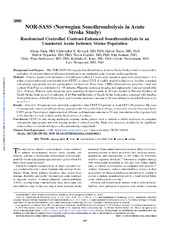| dc.contributor.author | Nacu, Aliona | en_US |
| dc.contributor.author | Kvistad, Christopher Elnan | en_US |
| dc.contributor.author | Næss, Halvor | en_US |
| dc.contributor.author | Øygarden, Halvor | en_US |
| dc.contributor.author | Logallo, Nicola | en_US |
| dc.contributor.author | Assmus, Jörg | en_US |
| dc.contributor.author | Waje-Andreassen, Ulrike | en_US |
| dc.contributor.author | Kurz, Kathinka Dæhli | en_US |
| dc.contributor.author | Neckelmann, Gesche F | en_US |
| dc.contributor.author | Thomassen, Lars | en_US |
| dc.date.accessioned | 2018-01-05T08:06:43Z | |
| dc.date.available | 2018-01-05T08:06:43Z | |
| dc.date.issued | 2016-02 | |
| dc.Published | Nacu A, Kvistad CE, Næss H, Øygarden H, Logallo N, Assmus J, Waje-Andreassen U, Kurz KU, Neckelmann GF, Thomassen L. NOR-SASS (Norwegian Sonothrombolysis in Acute Stroke Study): Randomized controlled contrast-enhanced sonothrombolysis in an unselected acute ischemic stroke population. Stroke. 2016;48(2):335-341 | eng |
| dc.identifier.issn | 0039-2499 | |
| dc.identifier.issn | 1524-4628 | |
| dc.identifier.uri | https://hdl.handle.net/1956/17133 | |
| dc.description.abstract | Background and Purpose—The NOR-SASS (Norwegian Sonothrombolysis in Acute Stroke Study) aimed to assess effect and safety of contrast-enhanced ultrasound treatment in an unselected acute ischemic stroke population. Methods—Patients treated with intravenous thrombolysis within 4.5 hours after symptom onset were randomized 1:1 to either contrast-enhanced sonothrombolysis (CEST) or sham CEST. A visible arterial occlusion on baseline computed tomography angiography was not a prerequisite for inclusion. Pulse-wave 2 MHz ultrasound was given for 1 hour and contrast (SonoVue) as an infusion for ≈30 minutes. Magnetic resonance imaging and angiography were performed after 24 to 36 hours. Primary study end points were neurological improvement at 24 hours defined as National Institutes of Health Stroke Scale score 0 or reduction of ≥4 National Institutes of Health Stroke Scale points compared with baseline National Institutes of Health Stroke Scale and favorable functional outcome at 90 days defined as modified Rankin scale score 0 to 1. Results—A total of 183 patients were randomly assigned to either CEST (93 patient) or sham CEST (90 patients). The rates of symptomatic intracerebral hemorrhage, asymptomatic intracerebral hemorrhage, or mortality were not increased in the CEST group. Neurological improvement at 24 hours and functional outcome at 90 days was similar in the 2 groups both in the intention-to-treat analysis and in the per-protocol analysis. Conclusions—CEST is safe among unselected ischemic stroke patients with or without a visible occlusion on computed tomography angiography and with varying grades of clinical severity. There was, however, statistically no significant clinical effect of sonothrombolysis in this prematurely stopped trial. | en_US |
| dc.language.iso | eng | eng |
| dc.publisher | Wolters Kluwer | eng |
| dc.rights | Attribution CC BY-NC-ND | eng |
| dc.rights.uri | https://creativecommons.org/licenses/by-nc-nd/4.0/ | eng |
| dc.subject | angiography | eng |
| dc.subject | brain | eng |
| dc.subject | Randomized controlled trial | eng |
| dc.subject | safety | eng |
| dc.subject | Stroke | eng |
| dc.title | NOR-SASS (Norwegian Sonothrombolysis in Acute Stroke Study): Randomized controlled contrast-enhanced sonothrombolysis in an unselected acute ischemic stroke population | en_US |
| dc.type | Peer reviewed | |
| dc.type | Journal article | |
| dc.date.updated | 2017-12-05T12:12:59Z | |
| dc.description.version | publishedVersion | en_US |
| dc.rights.holder | Copyright 2016 The Author(s) | |
| dc.identifier.doi | https://doi.org/10.1161/strokeaha.116.014644 | |
| dc.identifier.cristin | 1455420 | |
| dc.source.journal | Stroke | |

